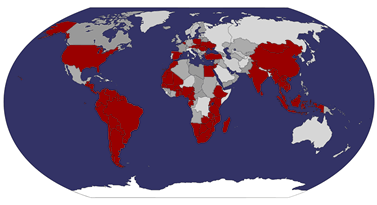Just wanted to apologize for the lack of posts and warn all four of our regular readers that it will probably be another couple of days, maybe more, before we are able to get more pictures and posts online. Sorry! We have just been too busy having fun in Chile to keep up with things, and tonight begin another 30-hour bus trip north. We will probably be in Peru before we are able to post again.
In the meantime, if you really need a newlyweds-traveling-the-world-blog fix we suggest that you check out Ben & Megan's blog! These are our friends who are also circling the earth, and we are actually hoping to meet up with them in Bolivia soon.
Countries Visited
Wednesday, September 30, 2009
Wednesday, September 23, 2009
Chilly weather, hot chillis...
...that's right, we're in Chile!
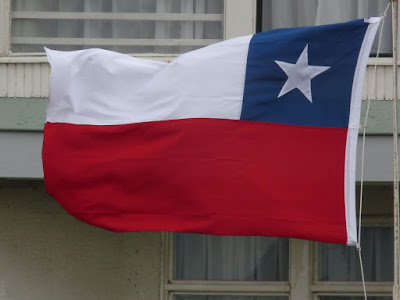
Exiting Argentina, we had to transfer buses in Punta Arenas, Chile, a couple of hours south of our final destination. We ended up with a couple of hours to kill in Punta Arenas, and I was glad, because I had read that there was a huge statue there featuring Magellan, a mermaid, and two native people. Indeed, there was.

Then it was on to Puerto Natales, the self-described "capital of adventure tourism in Patagonia!" Now, for a while, Andy and I had the bad habit of arriving into a new city on Sunday, when everything was closed. This time, we made it to Puerto Natales on a Friday...and it turned out to be Chilean Independence Day, and everything was closed.
But we did get to catch army regiments parading in the street...

...and go to a "fonda" of folk dancing, music, and food in the square right outside our hostel. Not bad!
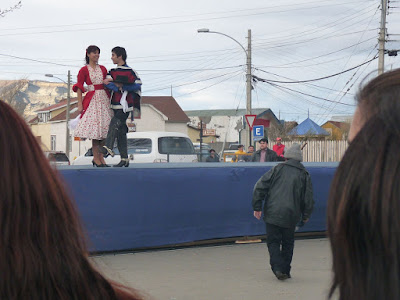
And we took a long walk around the harbor in town, spotting several fun birds. Too bad Andy is not writing this post, or maybe he could tell you something interesting about them.
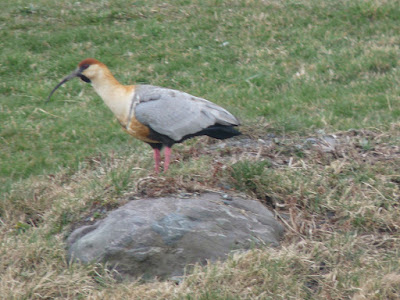
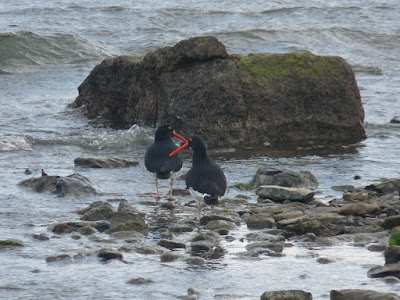
On our way back, it was really windy and cold and I really had to pee. Luckily, a kind older lady was driving down the road back to the town and asked us if we wanted to hop in. Continuing our fine tradition of hitchiking in South America, of course we did.
(Fun aside: We chatted a little in Spanish and told her our names. When she heard my name was Tara, she exclaimed at what an unusual name that was. Then we asked her name and it turned out to be Freesia, like the flower. Nothing like a lady named Freesia telling you you have an unusual name!)
Anyway, we eventually did find a few places inPN that were open to book trips and buy some provisions, so all was well.
But there were no Rocklets for sale in Chile, so we decided we had to turn around and go back to Argentina the next day. Oh, yeah, and there was also this glacier we wanted to see...

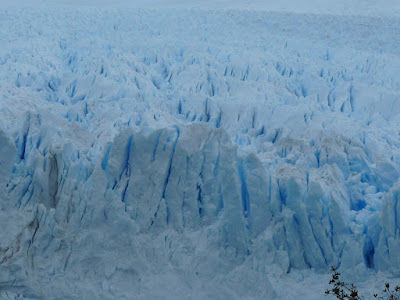 That was the Perito Moreno glacier in Glaciers National Park outside of El Calafate, Argentina. The glacier is enormous and has a crazy, spiky surface as you can see. While most glaciers in the world are receding due to global warming, Perito Moreno is in equilibrium, growing in the center as fast as it melts on the edges. We were lucky enough not only to see a HUGE chunk of it crash off into the lake but to take video footage of it as well, which we will try to post online soon.
That was the Perito Moreno glacier in Glaciers National Park outside of El Calafate, Argentina. The glacier is enormous and has a crazy, spiky surface as you can see. While most glaciers in the world are receding due to global warming, Perito Moreno is in equilibrium, growing in the center as fast as it melts on the edges. We were lucky enough not only to see a HUGE chunk of it crash off into the lake but to take video footage of it as well, which we will try to post online soon.
Note: The town of El Calafate, Argentina, appeared to be really overpriced and touristy, so if you want to go to the glacier, you may want to do it as a day trip from Puerto Natales, Chile, like we did. Although it was a looong day trip (7AM to 10PM) with border crossings in both directions, but you see wildlife like guanacos, rheas, and of course plenty of sheep on the drive.
Note 2: During the drive back, we reached a sheep grate that had not one, but two sheep stuck in it! It was dark and rainy, but our driver immediately jumped out of the bus and lifted each sheep out on his own. The sheep ran off into the darkness, apparently unhurt, and we cheered for the driver when he got back in the bus.
Note 3: With the number of times we have exited and reentered Argentina, I think we have an even dozen stamps from that country in our passports now!
OK, enough notes. Back to Chile!
The next day we set off for Torres del Paine national park in Chile. The day started with a stop at the cave where skin and bones from the milodon, or extinct giant sloth, were discovered. And what do you know, we encountered a real milodon! He was very friendly.
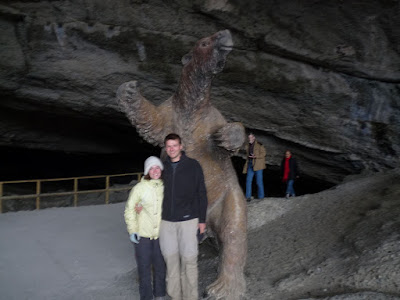
Then, en route to the park, we saw TONS of guanacos (the llama-like mammals that are common in Argentina and Chile) and finally got some good pictures of rheas (nandu in Spanish), the elusive emu-like birds that run around in the same areas.
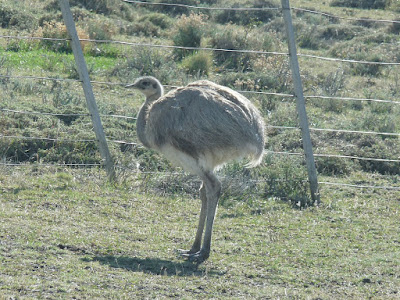
Finally, we reached the national park. It is a stunningly beautiful expanse of mountains, lakes, and glaciers. You can see the pointy, pink-hued granite peaks that the park is named for ("torres" is Spanish for towers) sticking up in the center of this picture.
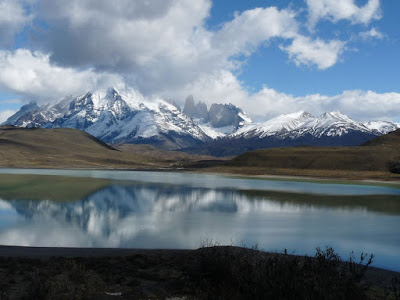
Our first day we spent on a full-day tour of the highlights of the park, which only encompassed a couple of little hikes. The best one was to a beach on a lake from which we could see Grey Glacier in the distance and loads of wind-sculpted icebergs that had broken off. You can see the glacier in this picture behind the lake, toward the right--it looks like a river of ice, which is exactly what it is.

Glacial ice is blue because the water is packed into it so densely.
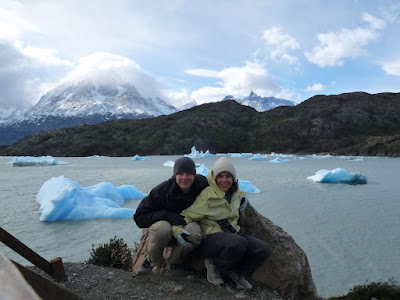
Exiting Argentina, we had to transfer buses in Punta Arenas, Chile, a couple of hours south of our final destination. We ended up with a couple of hours to kill in Punta Arenas, and I was glad, because I had read that there was a huge statue there featuring Magellan, a mermaid, and two native people. Indeed, there was.
Then it was on to Puerto Natales, the self-described "capital of adventure tourism in Patagonia!" Now, for a while, Andy and I had the bad habit of arriving into a new city on Sunday, when everything was closed. This time, we made it to Puerto Natales on a Friday...and it turned out to be Chilean Independence Day, and everything was closed.
But we did get to catch army regiments parading in the street...
...and go to a "fonda" of folk dancing, music, and food in the square right outside our hostel. Not bad!
And we took a long walk around the harbor in town, spotting several fun birds. Too bad Andy is not writing this post, or maybe he could tell you something interesting about them.
On our way back, it was really windy and cold and I really had to pee. Luckily, a kind older lady was driving down the road back to the town and asked us if we wanted to hop in. Continuing our fine tradition of hitchiking in South America, of course we did.
(Fun aside: We chatted a little in Spanish and told her our names. When she heard my name was Tara, she exclaimed at what an unusual name that was. Then we asked her name and it turned out to be Freesia, like the flower. Nothing like a lady named Freesia telling you you have an unusual name!)
Anyway, we eventually did find a few places inPN that were open to book trips and buy some provisions, so all was well.
But there were no Rocklets for sale in Chile, so we decided we had to turn around and go back to Argentina the next day. Oh, yeah, and there was also this glacier we wanted to see...
Note: The town of El Calafate, Argentina, appeared to be really overpriced and touristy, so if you want to go to the glacier, you may want to do it as a day trip from Puerto Natales, Chile, like we did. Although it was a looong day trip (7AM to 10PM) with border crossings in both directions, but you see wildlife like guanacos, rheas, and of course plenty of sheep on the drive.
Note 2: During the drive back, we reached a sheep grate that had not one, but two sheep stuck in it! It was dark and rainy, but our driver immediately jumped out of the bus and lifted each sheep out on his own. The sheep ran off into the darkness, apparently unhurt, and we cheered for the driver when he got back in the bus.
Note 3: With the number of times we have exited and reentered Argentina, I think we have an even dozen stamps from that country in our passports now!
OK, enough notes. Back to Chile!
The next day we set off for Torres del Paine national park in Chile. The day started with a stop at the cave where skin and bones from the milodon, or extinct giant sloth, were discovered. And what do you know, we encountered a real milodon! He was very friendly.
Then, en route to the park, we saw TONS of guanacos (the llama-like mammals that are common in Argentina and Chile) and finally got some good pictures of rheas (nandu in Spanish), the elusive emu-like birds that run around in the same areas.
Finally, we reached the national park. It is a stunningly beautiful expanse of mountains, lakes, and glaciers. You can see the pointy, pink-hued granite peaks that the park is named for ("torres" is Spanish for towers) sticking up in the center of this picture.
Our first day we spent on a full-day tour of the highlights of the park, which only encompassed a couple of little hikes. The best one was to a beach on a lake from which we could see Grey Glacier in the distance and loads of wind-sculpted icebergs that had broken off. You can see the glacier in this picture behind the lake, toward the right--it looks like a river of ice, which is exactly what it is.
Glacial ice is blue because the water is packed into it so densely.
We found this sign beside a road in the park. Andy thinks that it means "watch out for people who have one leg shorter than the other."
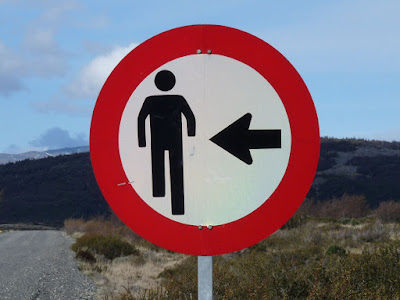
The next day, the real fun began. We stayed over in the park and left our hostel at 5:15AM to start the hike to the base of the Torres del Paine themselves. It was dark when we left, but soon the sun started to rise...
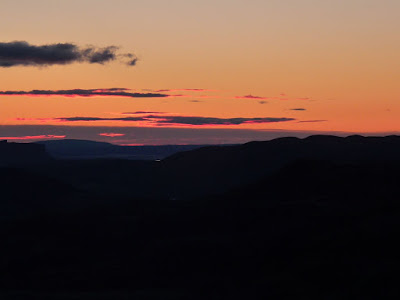
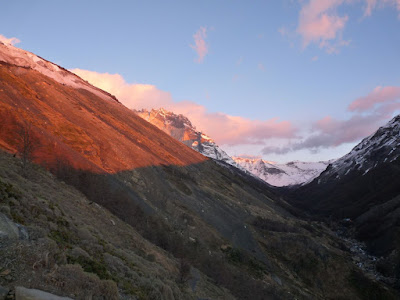
We went over hills and through valleys, hiking on dirt, through forest, and over rocky scree. It got snowier as we gained altitude.
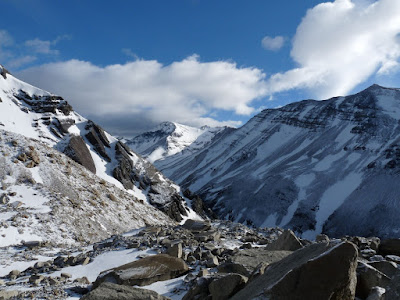
Just four hours later, we were rewarded with this close-up view of the Torres!
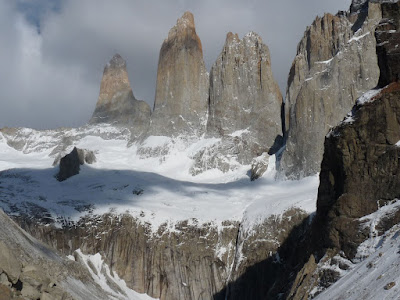
We didn't see another soul the whole way up...but, then, who took this picture???
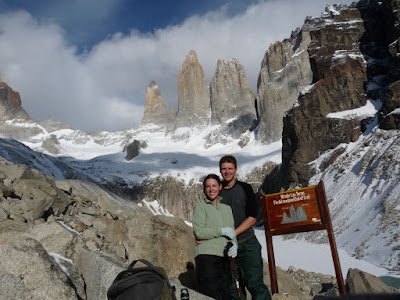
Here at the end of the trail, Andy kindly let me rest for 10 minutes and eat the rest of the Rocklets I had acquired in Argentina the day before. Then, it was time to hike all the way back--and quick-like, because we had to make the 2:30 bus at headquarters, which was an additional hour and a half walk back beyond our hostel.
We calculated that by the end of the day, we had hiked 17 miles in 8.5 hours. We have agreed that that is our longest hike ever in one day. We also agreed that, considering the circumstances, my amount of complaining during the hike was pretty moderate!
Today, we are sore. Guess that's why they call them the Towers of Pain, yuk yuk.
Finally, we leave you with this sign, which we encountered before a rather rickety-looking bridge on the hike back to the admin center. Guess if the bridge collapses, the driver is screwed!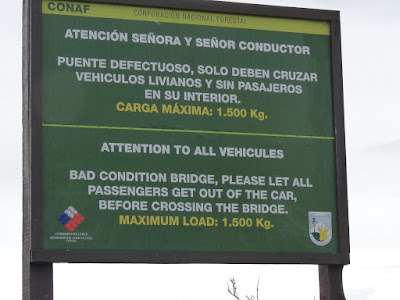
Now, we are off on this boat for three days. Hope that the tales of seasickness are greatly exaggerated...
The next day, the real fun began. We stayed over in the park and left our hostel at 5:15AM to start the hike to the base of the Torres del Paine themselves. It was dark when we left, but soon the sun started to rise...
We went over hills and through valleys, hiking on dirt, through forest, and over rocky scree. It got snowier as we gained altitude.
Just four hours later, we were rewarded with this close-up view of the Torres!
We didn't see another soul the whole way up...but, then, who took this picture???
Here at the end of the trail, Andy kindly let me rest for 10 minutes and eat the rest of the Rocklets I had acquired in Argentina the day before. Then, it was time to hike all the way back--and quick-like, because we had to make the 2:30 bus at headquarters, which was an additional hour and a half walk back beyond our hostel.
We calculated that by the end of the day, we had hiked 17 miles in 8.5 hours. We have agreed that that is our longest hike ever in one day. We also agreed that, considering the circumstances, my amount of complaining during the hike was pretty moderate!
Today, we are sore. Guess that's why they call them the Towers of Pain, yuk yuk.
Finally, we leave you with this sign, which we encountered before a rather rickety-looking bridge on the hike back to the admin center. Guess if the bridge collapses, the driver is screwed!
Now, we are off on this boat for three days. Hope that the tales of seasickness are greatly exaggerated...
Tuesday, September 22, 2009
More Questions
The questions just keep rolling in, even if about 90% are from one reader. Here is a sampling?
Q: What do you do without dressy clothes for the fancy performances?
A: It is true that we have nothing dressier than our zip-on pants and long sleeve t-shirts. We often look underdressed, but have not yet been thrown out. Some of the venues have had a no sandal policy, but sneakers seem to be fine. We won't be going to any black-tie events, and I doubt that we could get into many clubs, but we seem to be fine for cultural performances.
Q: How big are the maras (the giant guinea pig things)?
A: They are the size of a medium size dog and bigger than a cat. They probably weigh about 25 pounds. More information is available here.
Q: "That picture of the Welsh home looked like it was taken through Alice's Looking Glass! Is it for midgets?"
A: Once inside, it is actually tall enough to stand in comfortably, but I had to duck to go through doorways. People were a bit shorter then, but I think the first people there probably were not professional carpenters and did the best that they could.
Q: How come most of the Welsh settlers went to Canada?
A: The came to Argentina so that they could live how they wanted without being bothered by the government. Eventually, technology meant that the government of Argentina tried to start imposing laws and rule on them as well, so most of them then left for Canada.
Q: Did people speak English in the Welsh tea house?
A: Some, but many people in Argentina speak English. The Welsh villages didn't actually speak that much English--mostly Welsh. You can still find some people around who speak Welsh and some signs, but everyone learns Spanish as their first language.
Q: What is Agosto on that sign picture that Tara posted?
A: Yeah, I wouldn't know if I wasn't married to a playwright. August: Osage County is a broadway play that Tara loves and that has been a critical success in New York. If you don't live in New York, you have probably never heard of it.
Q: What exactly is mate?
A: It is a plant and they use the leaves to brew this crazy tea.
Q: Do the two of you ever fight?
A: Just about everyday. Mostly when we are lost, because one of us wants to buy something that the other does not, or because one of us wants to go somewhere that the other one does not. Most of these fights are short and we have no lasting problems. I have traveled with a lot of people and the fights were exactly the same, so it has little to do with the two of us...
Q: What do you do without dressy clothes for the fancy performances?
A: It is true that we have nothing dressier than our zip-on pants and long sleeve t-shirts. We often look underdressed, but have not yet been thrown out. Some of the venues have had a no sandal policy, but sneakers seem to be fine. We won't be going to any black-tie events, and I doubt that we could get into many clubs, but we seem to be fine for cultural performances.
Q: How big are the maras (the giant guinea pig things)?
A: They are the size of a medium size dog and bigger than a cat. They probably weigh about 25 pounds. More information is available here.
Q: "That picture of the Welsh home looked like it was taken through Alice's Looking Glass! Is it for midgets?"
A: Once inside, it is actually tall enough to stand in comfortably, but I had to duck to go through doorways. People were a bit shorter then, but I think the first people there probably were not professional carpenters and did the best that they could.
Q: How come most of the Welsh settlers went to Canada?
A: The came to Argentina so that they could live how they wanted without being bothered by the government. Eventually, technology meant that the government of Argentina tried to start imposing laws and rule on them as well, so most of them then left for Canada.
Q: Did people speak English in the Welsh tea house?
A: Some, but many people in Argentina speak English. The Welsh villages didn't actually speak that much English--mostly Welsh. You can still find some people around who speak Welsh and some signs, but everyone learns Spanish as their first language.
Q: What is Agosto on that sign picture that Tara posted?
A: Yeah, I wouldn't know if I wasn't married to a playwright. August: Osage County is a broadway play that Tara loves and that has been a critical success in New York. If you don't live in New York, you have probably never heard of it.
Q: What exactly is mate?
A: It is a plant and they use the leaves to brew this crazy tea.
Q: Do the two of you ever fight?
A: Just about everyday. Mostly when we are lost, because one of us wants to buy something that the other does not, or because one of us wants to go somewhere that the other one does not. Most of these fights are short and we have no lasting problems. I have traveled with a lot of people and the fights were exactly the same, so it has little to do with the two of us...
Thursday, September 17, 2009
Patagonia: More than a clothing company
So, what is Patagonia? We had a vague notion about it being somewhere in Argentina. As it turns out, Patagonia occupies about the bottom half of the country. It is almost entirely flat and almost no one lives there except for a few cities along the coasts. Not much can live there. Here are the pictures from our week in Patagonia. Tierra del Fuego, at the very southern end of South America, is not really like the rest of Patagonia, but those pictures are here as well.
Here is what most of Patagonia looks like. Some also has small shrubs and small ponds. We would go to sleep on the bus with it looking like this and then wake up to exactly the same thing. Sometimes it has sheep on it.
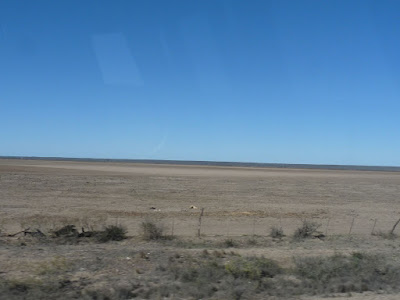 In Patagonia, they have guanacos, which are related to the llama. They are all wild--these just happen to be behind a sheep fence. They are one of the few native animals. I would compare them to deer in most parts of the US because you often see big groups of them grazing.
In Patagonia, they have guanacos, which are related to the llama. They are all wild--these just happen to be behind a sheep fence. They are one of the few native animals. I would compare them to deer in most parts of the US because you often see big groups of them grazing.
 We went to Valdes Penninsula in the northern part of Patagonia. It has much wildlife, but especially the Right Whale. It is apparently called that because it was the right whale to kill in the whaling days. It would float to the surface and tasted good with lots of blubber. Now it is protected and doing well.
We went to Valdes Penninsula in the northern part of Patagonia. It has much wildlife, but especially the Right Whale. It is apparently called that because it was the right whale to kill in the whaling days. It would float to the surface and tasted good with lots of blubber. Now it is protected and doing well.
 They have barnacles that also house small crabs all over them. Different whales are identified by the shape of these barnacles. This is its mouth, though hard to tell. They have these huge teeth-like things called ballenes that filter krill from the water. However, they don't really eat when they are in this location--they come to mate and have babies, then go back south to eat.
They have barnacles that also house small crabs all over them. Different whales are identified by the shape of these barnacles. This is its mouth, though hard to tell. They have these huge teeth-like things called ballenes that filter krill from the water. However, they don't really eat when they are in this location--they come to mate and have babies, then go back south to eat.
 Also on the Penninsula are elephant seals. These are the biggest seals in the world and can reach almost 10,000 pounds. That's right--the size of a minivan. We were there when the males were fighting for territory and could see some smaller ones that were wounded. This one was resting on the beach.
Also on the Penninsula are elephant seals. These are the biggest seals in the world and can reach almost 10,000 pounds. That's right--the size of a minivan. We were there when the males were fighting for territory and could see some smaller ones that were wounded. This one was resting on the beach.
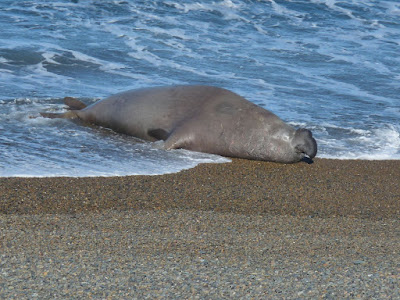 These animals are called maras or Patagonian cavies. They are like massive guinea pigs. They live in pairs and burrow into the ground.
These animals are called maras or Patagonian cavies. They are like massive guinea pigs. They live in pairs and burrow into the ground.
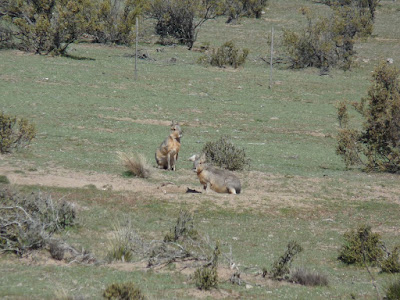 And penguins! Penguins only come here to breed and it is just the beginning of breeding season, so we only saw a few. The males come first and find nest sites. This is a recent arrival who looked happy with his nest. It was way up the hill, safe from the seals and orcas.
And penguins! Penguins only come here to breed and it is just the beginning of breeding season, so we only saw a few. The males come first and find nest sites. This is a recent arrival who looked happy with his nest. It was way up the hill, safe from the seals and orcas.
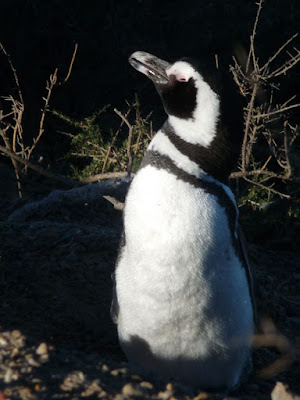 All aboard the Patagonian Express! A part of Patagonia was home to Welsh settlers in the 1800s and early 1900s. They brought with them all things Welsh and built trains to ship salt and other items among the Welsh towns. We assume the graffiti is more recent.
All aboard the Patagonian Express! A part of Patagonia was home to Welsh settlers in the 1800s and early 1900s. They brought with them all things Welsh and built trains to ship salt and other items among the Welsh towns. We assume the graffiti is more recent.
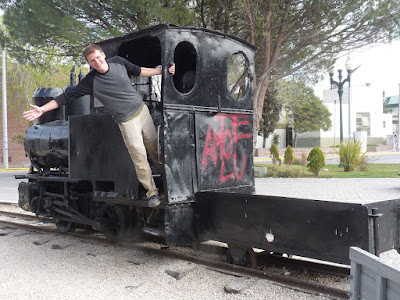 This was one of the first Welsh homes in the area. Very cozy inside. Most of the Welsh left and went to Canada in the 1900s, but there are still some Welsh descendents left and they still teach Welsh classes in some places.
This was one of the first Welsh homes in the area. Very cozy inside. Most of the Welsh left and went to Canada in the 1900s, but there are still some Welsh descendents left and they still teach Welsh classes in some places.
 Passing through the city of Rio Gallegos, we saw this boat rather far from the ocean. We assume a huge wave brought it on land. Given how little was in this city, shipwrecks are likely the only way the city adds to the population.
Passing through the city of Rio Gallegos, we saw this boat rather far from the ocean. We assume a huge wave brought it on land. Given how little was in this city, shipwrecks are likely the only way the city adds to the population.
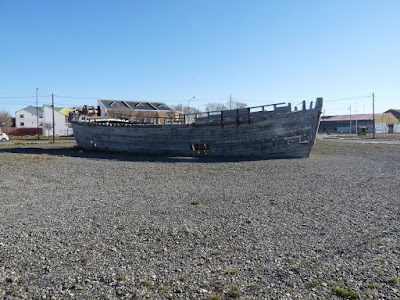 Here we are crossing the Straits of Magellan on a ferry to Tierra del Fuego. Very interesting to think about Magellan doing it 500 years ago. It was fairly cold at this point and we saw some penguins fishing.
Here we are crossing the Straits of Magellan on a ferry to Tierra del Fuego. Very interesting to think about Magellan doing it 500 years ago. It was fairly cold at this point and we saw some penguins fishing.
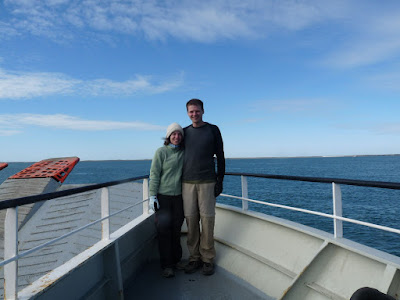 Tierra del Fuego consists of hills and mountains, unlike the rest of Patagonia. It gets cold in the winter, but not that cold. It rarely goes below 20 degrees and it doesn't get much above 70 in the summer. We are here right at the end of winter and it stays around freezing. Here is a great shot that Tara took from the bus on the way south.
Tierra del Fuego consists of hills and mountains, unlike the rest of Patagonia. It gets cold in the winter, but not that cold. It rarely goes below 20 degrees and it doesn't get much above 70 in the summer. We are here right at the end of winter and it stays around freezing. Here is a great shot that Tara took from the bus on the way south.
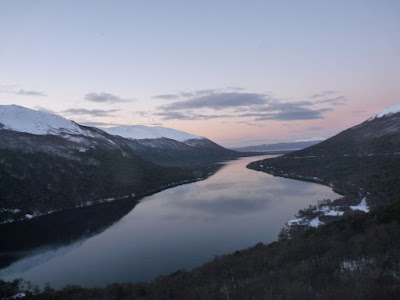 We went to Ushuaia, which is the southernmost city in the world and a beautiful city. (It has been built up in the last 20 years so that Argentina has more people in the area because Argentina and Chile have argued over the borders. This is a common trend in Argentina. They also have monuments to the Falklands, which they still claim despite losing a war over them. They also claim much of Antarctica.) We have done a good amount of hiking in the snow. After hiking to see the Martial Glacier (which we did not realize would be covered with snow and not actually possible to see) we built a lovely snow man. No trees around, so no arms. Sadly, this was the first snow man Tara had ever made.
We went to Ushuaia, which is the southernmost city in the world and a beautiful city. (It has been built up in the last 20 years so that Argentina has more people in the area because Argentina and Chile have argued over the borders. This is a common trend in Argentina. They also have monuments to the Falklands, which they still claim despite losing a war over them. They also claim much of Antarctica.) We have done a good amount of hiking in the snow. After hiking to see the Martial Glacier (which we did not realize would be covered with snow and not actually possible to see) we built a lovely snow man. No trees around, so no arms. Sadly, this was the first snow man Tara had ever made.
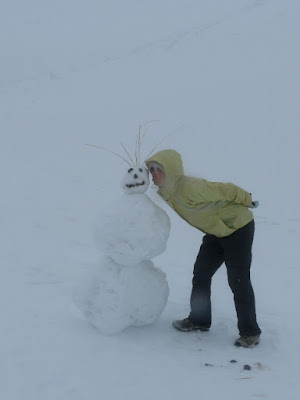 We took a chair lift up and down part of the hike because the trail was closed. Tara had also never been on a chair lift, so it was a day of firsts for her. I had never been on a chair lift with such nice views, though.
We took a chair lift up and down part of the hike because the trail was closed. Tara had also never been on a chair lift, so it was a day of firsts for her. I had never been on a chair lift with such nice views, though.
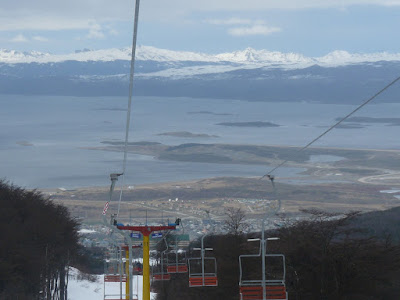 After hiking to see the glacier, we hiked through Tierra del Fuego National Park. Some lovely views and lots of mud. The hike was really great until it started sleeting. The weather here can change from sun to rain to snow and back again very quickly.
After hiking to see the glacier, we hiked through Tierra del Fuego National Park. Some lovely views and lots of mud. The hike was really great until it started sleeting. The weather here can change from sun to rain to snow and back again very quickly.
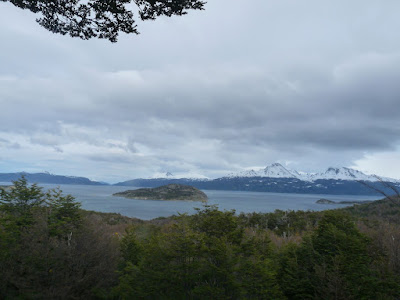 Not much grows down here. Most of the area is what is called peat bog, which is a bit like a swamp. Nothing decomposes because of the cold. Only a few types of trees grow here and then a lot of moss grows. Here you can see the moss and lichens growing on the trees. Note the lack of snow at the just slightly lower altitude.
Not much grows down here. Most of the area is what is called peat bog, which is a bit like a swamp. Nothing decomposes because of the cold. Only a few types of trees grow here and then a lot of moss grows. Here you can see the moss and lichens growing on the trees. Note the lack of snow at the just slightly lower altitude.
 These geese are the most common birds here. They live in pairs and the male and female are completely different colors. We think the white one is the male, but aren't sure.
These geese are the most common birds here. They live in pairs and the male and female are completely different colors. We think the white one is the male, but aren't sure.
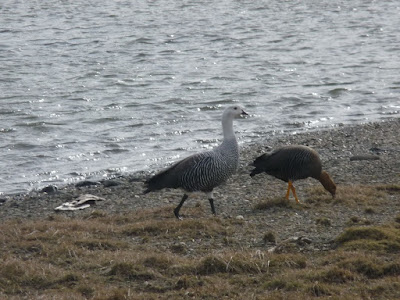 There are also several types of woodpeckers. I took this while searching for beavers, which we never saw. Beavers were imported to try to start a fur industry. Unfortunately, it does not get as cold here as in Canada, so the beavers don't grow a very thick fur. So, the furs can't be used for much, but the beavers have done a lot of damage to the ecosystem, creating big lakes that kill all the trees.
There are also several types of woodpeckers. I took this while searching for beavers, which we never saw. Beavers were imported to try to start a fur industry. Unfortunately, it does not get as cold here as in Canada, so the beavers don't grow a very thick fur. So, the furs can't be used for much, but the beavers have done a lot of damage to the ecosystem, creating big lakes that kill all the trees.
 We went snowshoeing for several miles with a group. Here is Tara about to enter the woods with her snowshoes. The forest was beautiful with the new snow on the trees. By the time we finished the hike, all the snow on the trees had melted.
We went snowshoeing for several miles with a group. Here is Tara about to enter the woods with her snowshoes. The forest was beautiful with the new snow on the trees. By the time we finished the hike, all the snow on the trees had melted.
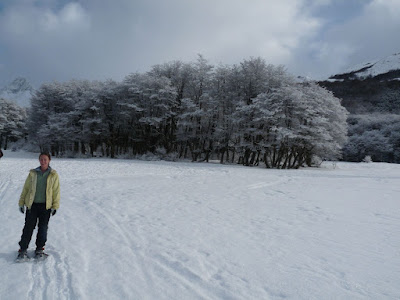 This is a large waterfall that apparently freezes during the winter, but it is now warm enough during the days that snow has started to melt and the waterfall has started to run again. It is interesting snowshoeing through the forest at this time of year because you often realize that you are hiking over a creek or river that is flowing under the snow.
This is a large waterfall that apparently freezes during the winter, but it is now warm enough during the days that snow has started to melt and the waterfall has started to run again. It is interesting snowshoeing through the forest at this time of year because you often realize that you are hiking over a creek or river that is flowing under the snow.
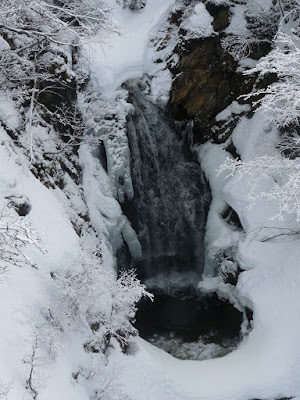 Us together in a valley on our snowshoe trip. This picture will allow my family to note that I am wearing a coat. I told Tara the other day that when I put on my coat it made my sleeves go up. She informed me that this is common when wearing a coat and that I may need to hold my sleeves while putting on the coat, and that I would know that if I ever wore a coat. One more reason not to wear a coat.
Us together in a valley on our snowshoe trip. This picture will allow my family to note that I am wearing a coat. I told Tara the other day that when I put on my coat it made my sleeves go up. She informed me that this is common when wearing a coat and that I may need to hold my sleeves while putting on the coat, and that I would know that if I ever wore a coat. One more reason not to wear a coat.
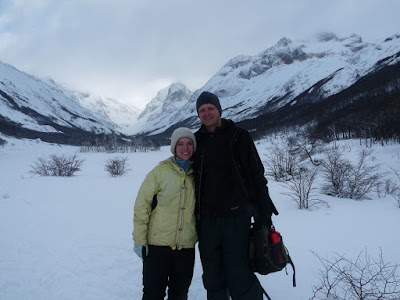 After showshoeing, we went for a dog sled ride. We didn't actually get to drive the sled, but it was still fun. We also learned that the sled stops anytime one of the dogs has to go to the bathroom, which turns out to be a lot. Hadn't ever thought about that.
After showshoeing, we went for a dog sled ride. We didn't actually get to drive the sled, but it was still fun. We also learned that the sled stops anytime one of the dogs has to go to the bathroom, which turns out to be a lot. Hadn't ever thought about that.
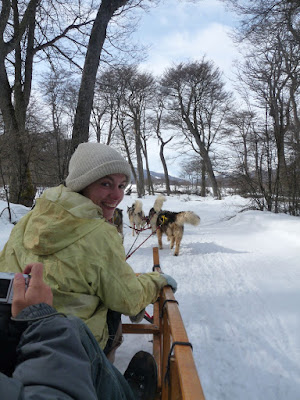 That wraps up Tierra del Fuego and Patagonia. Expect more snow and mountains in coming posts. We now begin our trip back north. Let's hope it is as good as the trip south.
That wraps up Tierra del Fuego and Patagonia. Expect more snow and mountains in coming posts. We now begin our trip back north. Let's hope it is as good as the trip south.
Here is what most of Patagonia looks like. Some also has small shrubs and small ponds. We would go to sleep on the bus with it looking like this and then wake up to exactly the same thing. Sometimes it has sheep on it.
Wednesday, September 16, 2009
Foods of Uruguay and Argentina
Greetings from Ushuaia, Argentina, the southernmost city in the world! We are in a veritable winter wonderland here and are having a terrific time...well, at least until we leave at 5:30 tomorrow morning for the all-day bus trip to Chile.
Anyway, we had trouble getting online in the last couple of towns, so we are way behind on blogging again. I have been tasked with catching you up with all of the tasty foods we've been eating lately, and oh boy, there are lots.
Buenos Aires, Part 1
Our visit to BA took place in two parts, the bread in the sandwich around our meaty (literally) trip to Uruguay.
One of the first places we visited in BA was the famous Cafe Torino, a 100+ year old cafe in the center of the city. Beautiful.
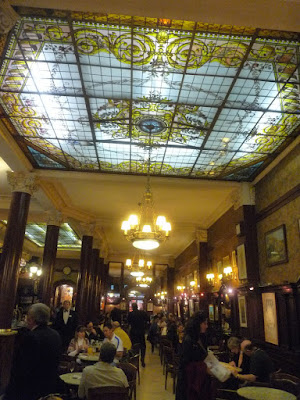
And the hot chocolate and churros--yum!!
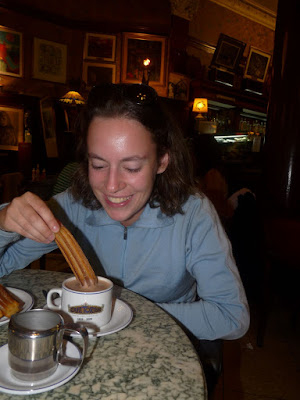
Andy's favorite thing about Argentina has to be that, instead of vanilla and chocolate, the soft ice cream flavors at McDonald's here are vanilla and dulce de leche. And, in BA, we found cones for 2 pesos, or 50 cents. He had many.

Good Activia flavors here, too. This one's pear and kiwi, one of my favorites so far.

While I enjoyed my Activia, Andy enjoyed this triangular meat pie.
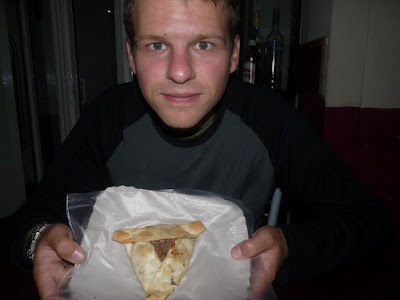
On our second day in BA, we went to take a healthful walk through the protected marshland park. I started off pretty healthily with some fresh-squeezed orange juice from a street vendor in the San Telmo neighborhood.
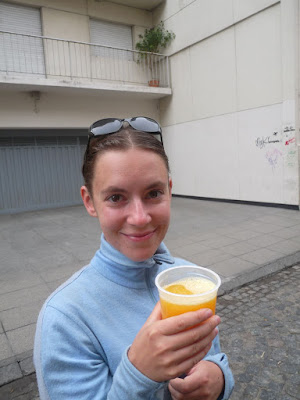
But then we came upon a kind of street fair...and of course someone had to try the apple-filled pastry...
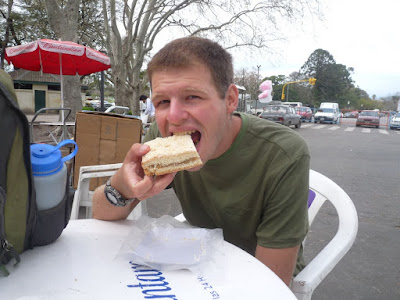
...and a choripan, (grilled chorizo sausage sandwich)...

(An Andy's-eye-view of the choripan)

...and a slice of membrillo pie. Membrillo is a quince paste.

I thought I liked quince, but actually I don't like membrillo so much, and it is a very popular filling here. Luckily, there is usually also a dulce de leche option. Like these white chocolate iced, dulce filled churros we got later that day, 6 for less than $2 US.
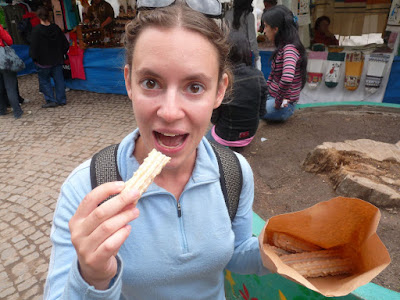
Uruguay
The healthy eating continued into Uruguay the next day. When we arrived in the Montevideo bus station in the morning, it was pouring rain outside, and we had left our rain gear in BA, so we decided to kill a bit of time until the rain let up and get something to eat.
Then Andy found whole dulce de leche filled pies for US$4...breakfast! Yes, we ate the whole thing.
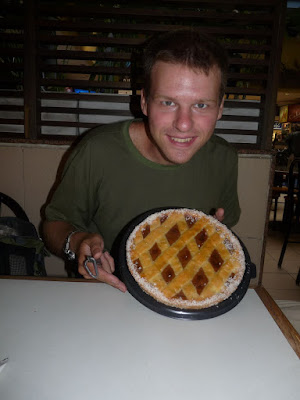
For lunch, we decided to splash out on a meatfest at the traditional Mercado del Puerto. It was kind of touristy and we probably overpaid for Uruguay, but it was still pretty cheap by US standards and the atmosphere was fun inside the market.
We started with chorizo.
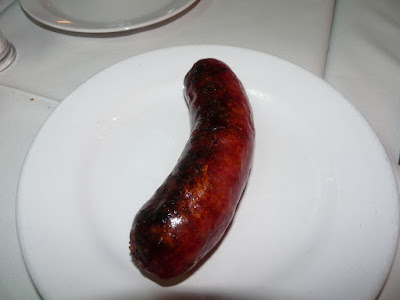
Then Andy got some steak cut and I got a rib cut. Look how much meat they gave me!
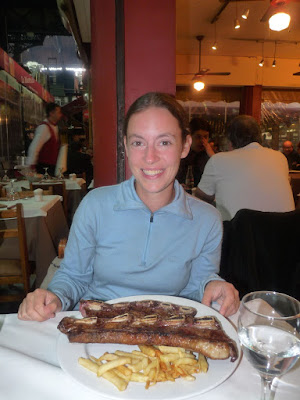
Happy couple at the meatery.
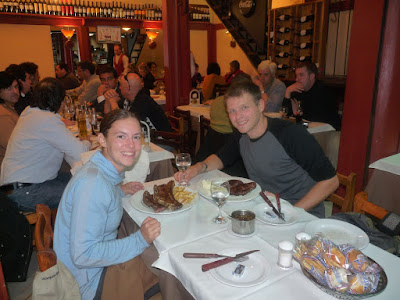
(It was actually soon after these excesses that I decided to go vegetarian for a while, so I haven't eaten any meat in almost a week. We'll see how long this lasts, as South America is definitely not the easiest place to eat veg, but I am trying.)
As you may have read, Uruguay is obsessed with all cow products, not just meat. So of course we had to try some ice cream. Ice cream is sold by the kilo here, and Andy has determined that 1/2 kilo is the closest denomination to his traditional pint serving size, but I think it is bigger.
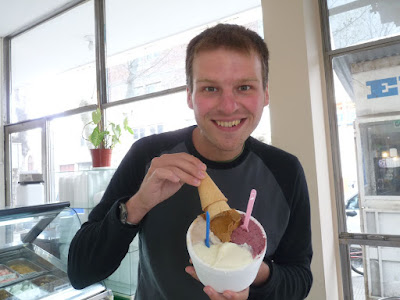
Uruguay has well-known dairy collective called Conaprole, and I picked up one of their yogurts to try. Stupidly, I didn't try it til we were on the ferry back to Argentina, where of course I haven't been able to find it since. It was very creamy and delicious, the best yogurt I have had yet in South America!

BA, Part 2
Not far from the ferry drop-off point in the La Boca section of Buenos Aires, we found a man grilling these disks of bread on the street. We were cold, and they were warm and salty and cheap (50 cents) so we got one.

A bit further on in the San Telmo market we found phyllo dough pastries filled with, you guessed it, dulce de leche!

The next day, we splashed out on ice cream at Freddo, a fancy and expensive local chain. Here you see banana, cinnamon, and dulce de leche flavors. Really fantastic, worth the $7 per half kilo in my opinion, though Andy kinda choked on the price.

Patagonia
We were sad to leave BA, where we also enjoyed a couple of cheap dinners out (one of which was an all you can eat buffet of pizza, pasta, salad, and empanadas for less than $5 per person). But we had to start eating our way south into Patagonia!
The local bakery in our first stop, Puerto Madryn, had these tasty jam-filled triangles, which we had for breakfast the first day. The second morning, we got dulce de leche filled donutty things at the same place.
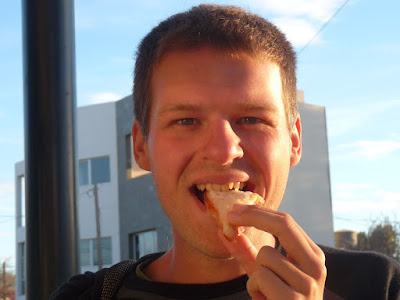
Oh, here is a glamour shot of the Paraguayan peanut butter we've been eating on the beach our whale-watching tour left from on the Peninsula Valdez. It's all gone now and we are peanut butterless, never found any in Argentina.

This one is for Aunt Judy--look, I am eating seafood! Octopus, I think, which is caught locally there, and a little fish fillet that was also tasty. This was at another all-you-can-eat place, a higher-end one in Puerto Madryn that cost a whopping $10 per person for salad, pasta bar, seafood, and parilla (the ubiquitous Argentine mixed grill--at this place, you could get lamb, beef, and sausage).
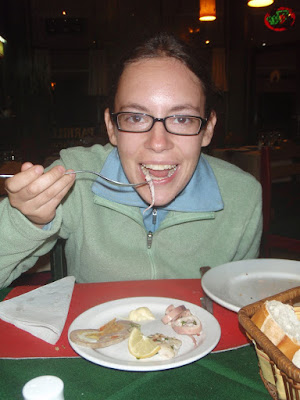
Our hotel in Puerto Madryn actually had a kitchen we could use, so on our last nightt here, we cooked a meal for the first time since we came on this trip. Yes, kind of pathetic that it took that long, but really we haven't stayed at many places with kitchens.
We made whole wheat pasta with chickpeas, spinach, mushrooms, and a lot of garlic. Healthiest meal we had had in some time. The spinach and garlic were really cheap here; everything else cost about as much as it would at a US grocery store.
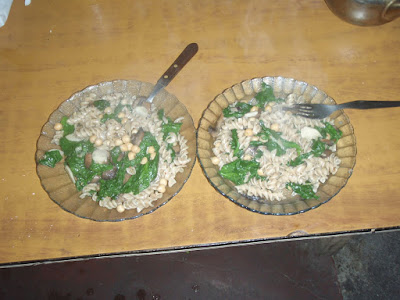
Side story: We actually made the same exact dish last night in Ushuaia, where we are staying at Familia Velasquez, a B&B that is basically just an (incredibly sweet) elderly gentleman's house--we sleep in one of the upstairs bedrooms, and he makes us tea and toasts us bread in the morning.
We are his first tourists of the season, and he speaks no English but he complimented me on my Spanish and I do my best to make converstaion with him, so we think he likes us. Anyway, we had a lot of extra pasta last night so I offered him some for his dinner and he partook. He told us that he liked it and said that it was a "different kind of meal" for him, because when he has pasta it is usually with meat. Yes, a meal without meat really is a foreign concept here. OK, end side story.
Did you know that a bunch of people from Wales came over to Patagonia a century or so ago and tried to set up a colony there? No joke. Apparently, they maintained their language for several generations, but it's dying out now.
In the small town of Gaiman, though, not far from Puerto Madryn and its neighborhing city, Trelew, there are a whole bunch of Welsh teahouses, where they will serve you a traditional British high tea. Our book called it an "excessive" amount of food, so of course we had to go. We chose Plas y Coed, the oldest teahouse, and were not disappointed.
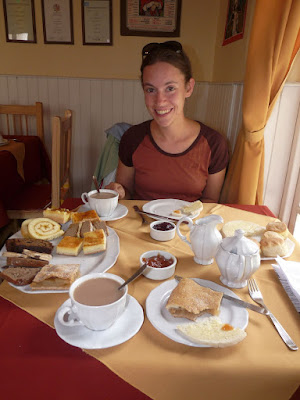
Well, I wasn't disappointed, anyway. Apparently, it takes a lot more than two scones and six cakes apiece to qualify as excessive in Andy's book.
Here is a sweet called an alfajor. It is like cake with a layer of dulce de leche inside, all covered in chocolate. We don't think they are very good, but maybe that's because the only ones we've tried are the prepackaged ones we've gotten for free as snacks on long-haul bus rides...
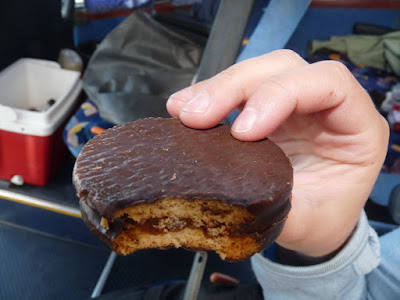
Down here in Ushuaia, there is no real street food, so we have to eat the snow.
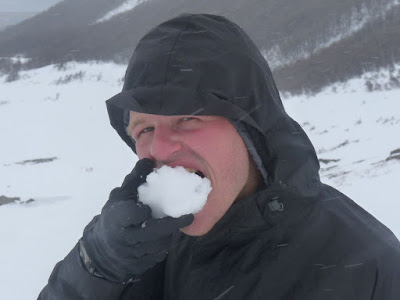
Ushuaia is where I finally bought a packet of Rocklets, the Argentine knockoff of peanut M&Ms. Pretty tasty for half the price of real M&Ms.
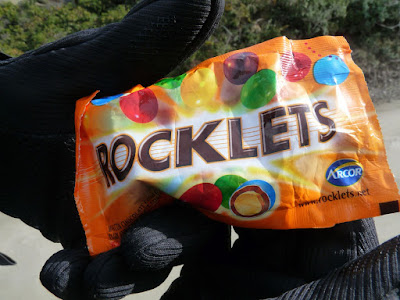
We're off to Chile tomorrow, so hopefully we'll have a whole new country's worth of foods to report on soon!
Anyway, we had trouble getting online in the last couple of towns, so we are way behind on blogging again. I have been tasked with catching you up with all of the tasty foods we've been eating lately, and oh boy, there are lots.
Buenos Aires, Part 1
Our visit to BA took place in two parts, the bread in the sandwich around our meaty (literally) trip to Uruguay.
One of the first places we visited in BA was the famous Cafe Torino, a 100+ year old cafe in the center of the city. Beautiful.
And the hot chocolate and churros--yum!!
Andy's favorite thing about Argentina has to be that, instead of vanilla and chocolate, the soft ice cream flavors at McDonald's here are vanilla and dulce de leche. And, in BA, we found cones for 2 pesos, or 50 cents. He had many.
Good Activia flavors here, too. This one's pear and kiwi, one of my favorites so far.
While I enjoyed my Activia, Andy enjoyed this triangular meat pie.
On our second day in BA, we went to take a healthful walk through the protected marshland park. I started off pretty healthily with some fresh-squeezed orange juice from a street vendor in the San Telmo neighborhood.
But then we came upon a kind of street fair...and of course someone had to try the apple-filled pastry...
...and a choripan, (grilled chorizo sausage sandwich)...
(An Andy's-eye-view of the choripan)
...and a slice of membrillo pie. Membrillo is a quince paste.
I thought I liked quince, but actually I don't like membrillo so much, and it is a very popular filling here. Luckily, there is usually also a dulce de leche option. Like these white chocolate iced, dulce filled churros we got later that day, 6 for less than $2 US.
Uruguay
The healthy eating continued into Uruguay the next day. When we arrived in the Montevideo bus station in the morning, it was pouring rain outside, and we had left our rain gear in BA, so we decided to kill a bit of time until the rain let up and get something to eat.
Then Andy found whole dulce de leche filled pies for US$4...breakfast! Yes, we ate the whole thing.
For lunch, we decided to splash out on a meatfest at the traditional Mercado del Puerto. It was kind of touristy and we probably overpaid for Uruguay, but it was still pretty cheap by US standards and the atmosphere was fun inside the market.
We started with chorizo.
Then Andy got some steak cut and I got a rib cut. Look how much meat they gave me!
Happy couple at the meatery.
(It was actually soon after these excesses that I decided to go vegetarian for a while, so I haven't eaten any meat in almost a week. We'll see how long this lasts, as South America is definitely not the easiest place to eat veg, but I am trying.)
As you may have read, Uruguay is obsessed with all cow products, not just meat. So of course we had to try some ice cream. Ice cream is sold by the kilo here, and Andy has determined that 1/2 kilo is the closest denomination to his traditional pint serving size, but I think it is bigger.
Uruguay has well-known dairy collective called Conaprole, and I picked up one of their yogurts to try. Stupidly, I didn't try it til we were on the ferry back to Argentina, where of course I haven't been able to find it since. It was very creamy and delicious, the best yogurt I have had yet in South America!
BA, Part 2
Not far from the ferry drop-off point in the La Boca section of Buenos Aires, we found a man grilling these disks of bread on the street. We were cold, and they were warm and salty and cheap (50 cents) so we got one.
A bit further on in the San Telmo market we found phyllo dough pastries filled with, you guessed it, dulce de leche!
The next day, we splashed out on ice cream at Freddo, a fancy and expensive local chain. Here you see banana, cinnamon, and dulce de leche flavors. Really fantastic, worth the $7 per half kilo in my opinion, though Andy kinda choked on the price.
Patagonia
We were sad to leave BA, where we also enjoyed a couple of cheap dinners out (one of which was an all you can eat buffet of pizza, pasta, salad, and empanadas for less than $5 per person). But we had to start eating our way south into Patagonia!
The local bakery in our first stop, Puerto Madryn, had these tasty jam-filled triangles, which we had for breakfast the first day. The second morning, we got dulce de leche filled donutty things at the same place.
Oh, here is a glamour shot of the Paraguayan peanut butter we've been eating on the beach our whale-watching tour left from on the Peninsula Valdez. It's all gone now and we are peanut butterless, never found any in Argentina.
This one is for Aunt Judy--look, I am eating seafood! Octopus, I think, which is caught locally there, and a little fish fillet that was also tasty. This was at another all-you-can-eat place, a higher-end one in Puerto Madryn that cost a whopping $10 per person for salad, pasta bar, seafood, and parilla (the ubiquitous Argentine mixed grill--at this place, you could get lamb, beef, and sausage).
Our hotel in Puerto Madryn actually had a kitchen we could use, so on our last nightt here, we cooked a meal for the first time since we came on this trip. Yes, kind of pathetic that it took that long, but really we haven't stayed at many places with kitchens.
We made whole wheat pasta with chickpeas, spinach, mushrooms, and a lot of garlic. Healthiest meal we had had in some time. The spinach and garlic were really cheap here; everything else cost about as much as it would at a US grocery store.
Side story: We actually made the same exact dish last night in Ushuaia, where we are staying at Familia Velasquez, a B&B that is basically just an (incredibly sweet) elderly gentleman's house--we sleep in one of the upstairs bedrooms, and he makes us tea and toasts us bread in the morning.
We are his first tourists of the season, and he speaks no English but he complimented me on my Spanish and I do my best to make converstaion with him, so we think he likes us. Anyway, we had a lot of extra pasta last night so I offered him some for his dinner and he partook. He told us that he liked it and said that it was a "different kind of meal" for him, because when he has pasta it is usually with meat. Yes, a meal without meat really is a foreign concept here. OK, end side story.
Did you know that a bunch of people from Wales came over to Patagonia a century or so ago and tried to set up a colony there? No joke. Apparently, they maintained their language for several generations, but it's dying out now.
In the small town of Gaiman, though, not far from Puerto Madryn and its neighborhing city, Trelew, there are a whole bunch of Welsh teahouses, where they will serve you a traditional British high tea. Our book called it an "excessive" amount of food, so of course we had to go. We chose Plas y Coed, the oldest teahouse, and were not disappointed.
Well, I wasn't disappointed, anyway. Apparently, it takes a lot more than two scones and six cakes apiece to qualify as excessive in Andy's book.
Here is a sweet called an alfajor. It is like cake with a layer of dulce de leche inside, all covered in chocolate. We don't think they are very good, but maybe that's because the only ones we've tried are the prepackaged ones we've gotten for free as snacks on long-haul bus rides...
Down here in Ushuaia, there is no real street food, so we have to eat the snow.
Ushuaia is where I finally bought a packet of Rocklets, the Argentine knockoff of peanut M&Ms. Pretty tasty for half the price of real M&Ms.
We're off to Chile tomorrow, so hopefully we'll have a whole new country's worth of foods to report on soon!
Subscribe to:
Posts (Atom)

